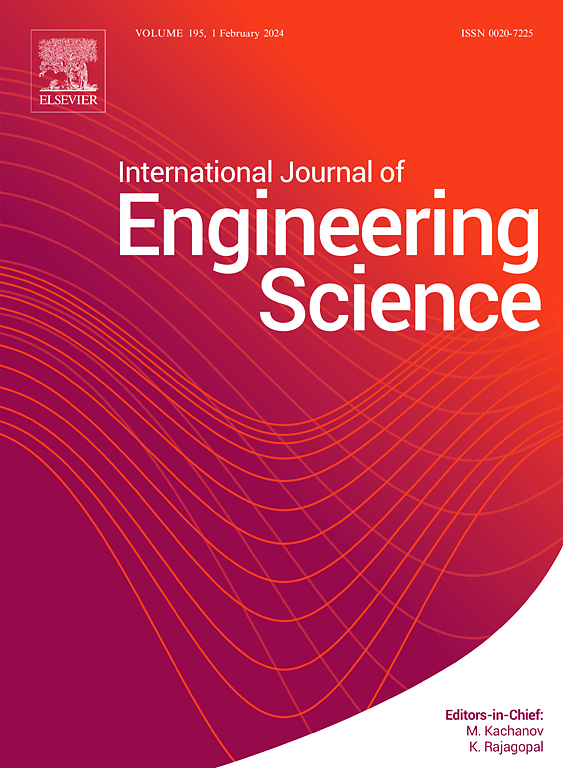智能旋转微盘的三维动力学研究
IF 5.7
1区 工程技术
Q1 ENGINEERING, MULTIDISCIPLINARY
International Journal of Engineering Science
Pub Date : 2025-03-07
DOI:10.1016/j.ijengsci.2025.104236
引用次数: 0
摘要
本文研究了旋转智能压柔磁多功能微盘的三维动力学分析。在数学建模中,试图开发出影响所分析结构的各种因素,该结构旨在用作微传感器/执行器。所研究的智能微盘具有许多灵敏、精确的应用,特别是在航空航天工业中。几何形状假定为环形微尺度结构。考虑了所分析的圆盘材料在小尺度上可观察到的柔性磁性,这是影响本研究的主要因素之一。由于环形微盘的角度旋转,可以在微妙的条件下控制传感过程,特别是在受微重力影响的环境中。根据三维弹性理论对智能微盘进行了全面的动力学仿真,然后利用能量法提取了智能微盘的控制方程。研究了几个参数对数值结果的影响。基于所分析结构的压电-柔性磁效应,得到了变形结果,为先进技术应用的精密传感器/执行器的设计提供了基础。提出的理论模型为扩展实验任务提供了合适的方法。值得注意的是,本文给出的方程是原创的,可以作为该领域的基准参考。综上所述,我们发现微盘的转速与周围的磁场有直接的联系,高角速度可以阻碍磁致机械负载的影响。本文章由计算机程序翻译,如有差异,请以英文原文为准。
On three-dimensional dynamics of smart rotating micro-disks
In this paper, three-dimensional (3D) dynamic analysis of a rotational smart piezomagnetic-flexomagnetic (PFM) multi-functional micro-disk has been investigated. In the mathematical modeling, an attempt has been made to develop a wide range of factors influencing the analyzed structure, which is intended to be used as a micro-sensor/actuator. The investigated smart micro-disk could have many sensitive and accurate applications, especially in the aerospace industry. The geometry is assumed to be an annular microscale structure. Flexomagnetic property, observable on the small scale, has been considered for the material of the analyzed disk, and is one of the principal factors influencing the present research. Due to the angular rotation of the annular micro-disk, it is possible to control the sensing process in delicate conditions, particularly in environments influenced by microgravity. A comprehensive dynamic simulation is performed according to the 3D elasticity, then the governing equations of the smart micro-disk are extracted using the energy method. The effect of several parameters on the numerical results has been thoroughly examined. The deformation results, based on the piezo-flexomagnetic effect of the analyzed structure, have been obtained, enabling the design of precise sensors/actuators for advanced technological applications. The presented theoretical model offers a suitable approach for extending experimental tasks. It should be noted that the equations presented in this paper are original and can serve as a benchmark reference in this field. In conclusion, we found that there is a direct link between the rotational speed of the micro-disk and the surrounding magnetic field, and high angular velocities can impede the influence of the magnetic-induced mechanical load.
求助全文
通过发布文献求助,成功后即可免费获取论文全文。
去求助
来源期刊

International Journal of Engineering Science
工程技术-工程:综合
CiteScore
11.80
自引率
16.70%
发文量
86
审稿时长
45 days
期刊介绍:
The International Journal of Engineering Science is not limited to a specific aspect of science and engineering but is instead devoted to a wide range of subfields in the engineering sciences. While it encourages a broad spectrum of contribution in the engineering sciences, its core interest lies in issues concerning material modeling and response. Articles of interdisciplinary nature are particularly welcome.
The primary goal of the new editors is to maintain high quality of publications. There will be a commitment to expediting the time taken for the publication of the papers. The articles that are sent for reviews will have names of the authors deleted with a view towards enhancing the objectivity and fairness of the review process.
Articles that are devoted to the purely mathematical aspects without a discussion of the physical implications of the results or the consideration of specific examples are discouraged. Articles concerning material science should not be limited merely to a description and recording of observations but should contain theoretical or quantitative discussion of the results.
 求助内容:
求助内容: 应助结果提醒方式:
应助结果提醒方式:


